Zwiebelkuchen (German Onion Pie)
This post may contain affiliate links. See my disclosure policy.
Authentic German Zwiebelkuchen recipe from the heart of Swabia in southern Germany! Loads of caramelized onions and savory bacon are packed into this incredibly delicious pie that has been a favorite for generations!
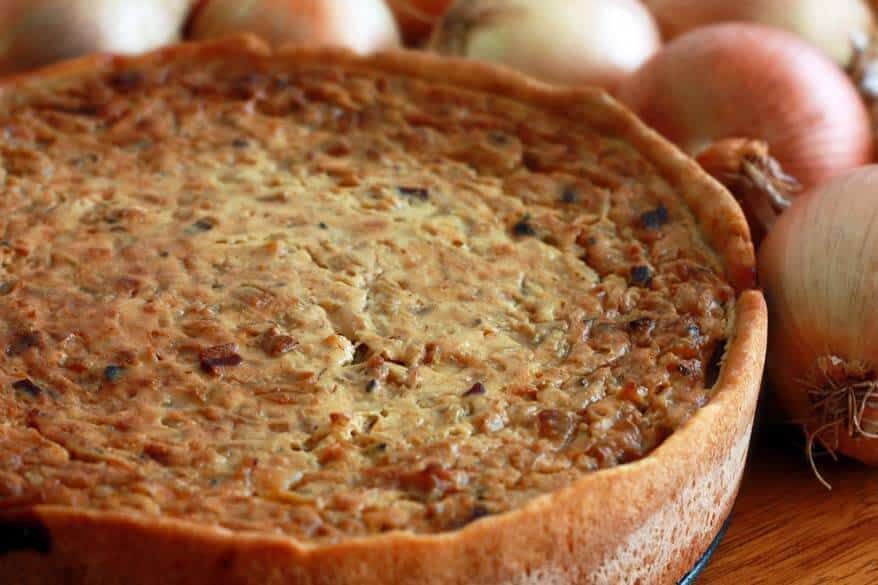
What is Zwiebelkuchen?
Autumn in Germany means a great many things to me, among them the brilliance of leaves changing color, harvested grapes from scenic hillsides, and Zwiebelkuchen, one of my favorite baked goods. This directly translates to “onion cake” but it’s actually a delicious savory pie.
Growing up in southern Germany, I always looked forward to the Fall, one reason being that it meant enjoying this incredibly delicious German Zwiebelkuchen. Another reason – grape season. Traditionally Zwiebelkuchen is enjoyed with a glass of Federweisser, or grape must. Not being an alcohol drinker, I always enjoyed it with a glass of delicious freshly squeezed grape juice. During the Fall, right after the grape harvests, you can find roadside stands selling it in large jugs and never did a year go by that we didn’t stop at least once to load up.
There are a few varieties of Zwiebelkuchen, depending which region you’re in. Some are flat and cut into squares with a thinner layer of the topping, others are thicker and deeper like pie. This version is from Swabia where I grew up. A favorite past-time is going to the Black Forest in the Fall and enjoying a slice of Schwäbischer Zwiebelkuchen at a Cafe, made with delicious local Black Forest bacon.
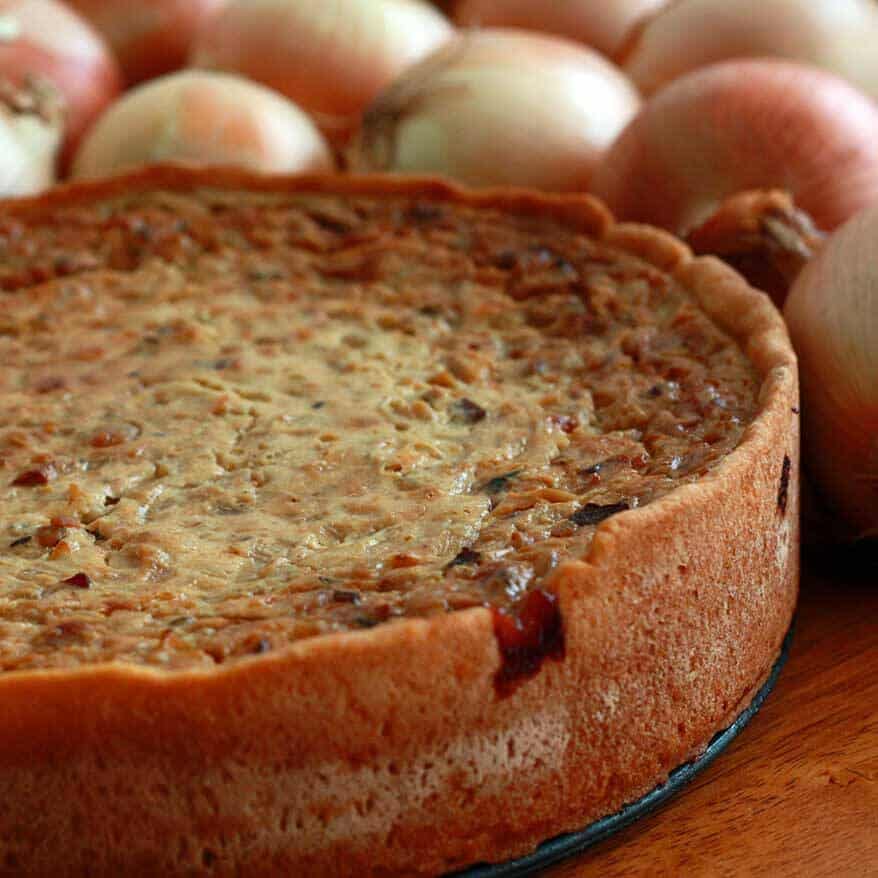
Swabian Zwiebelkuchen is typically round and deep, like quiche, though the flat varieties can also be found in bakeries throughout southern Germany. But whatever the shape, traditional Zwiebelkuchen always consists of yeast dough, topped with buttery caramelized onions, savory bacon, and a thick creamy base. Often, as in this version, caraway seeds are also included which add a wonderful depth and dimension of flavor.
I developed this recipe a few years ago as Autumn set in and I was craving the Zwiebelkuchen I always enjoyed in Germany. If you like onions, butter and bacon, you will love this Zwiebelkuchen, guaranteed!
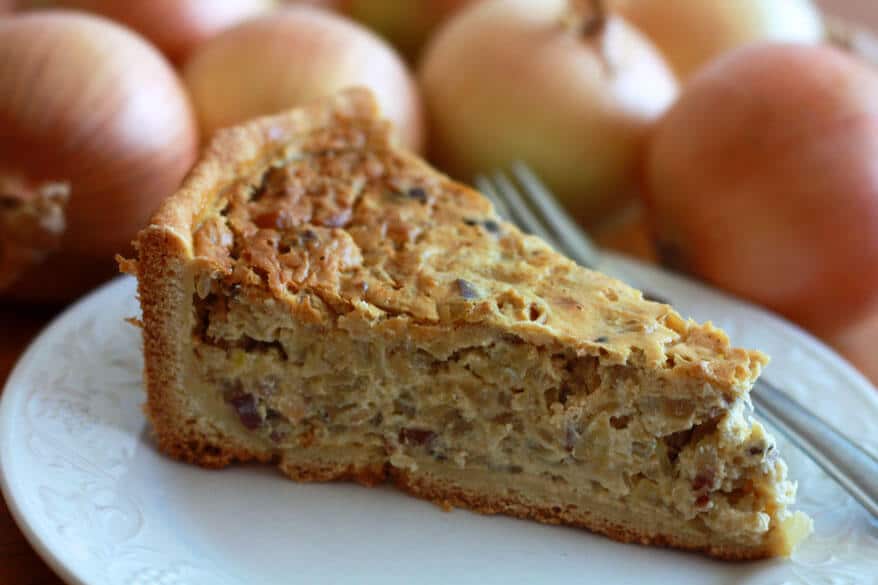
Zwiebelkuchen Recipe
Let’s get started!
Use good quality bacon with a nice, smoky flavor for best results. Fry the bacon until crispy.

Add the onions and cook for 30-30 minutes until nicely caramelized.
Let the onion mixture cool.
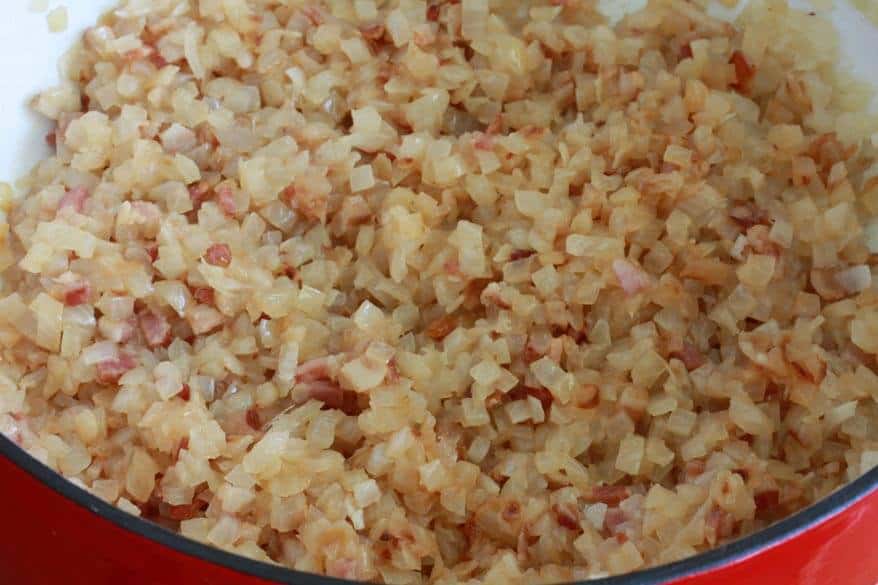
Combine all the filling ingredients in a bowl.
Beat until combined.

Add the onion mixture and stir to combine.
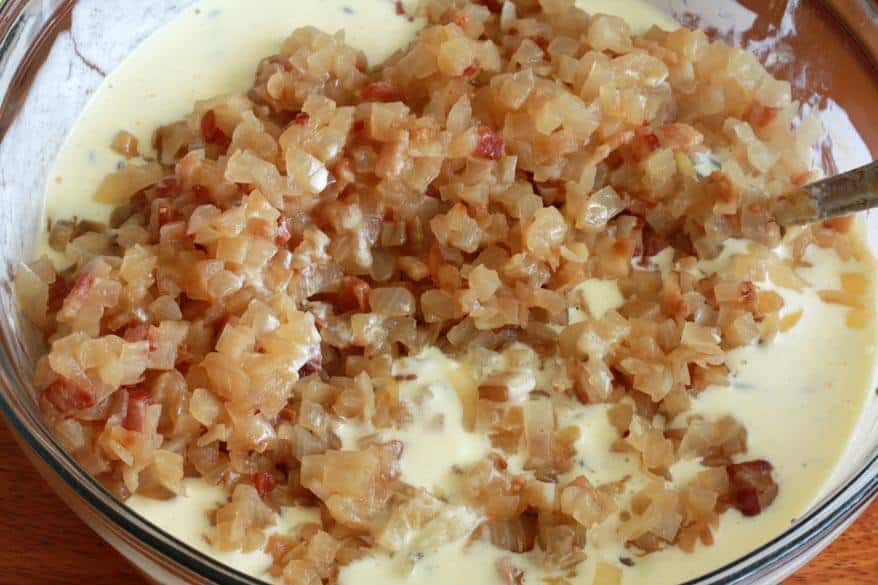
Pour the filling mixture into the prepared crust in a 9 to 10 inch springform (see recipe card below for instructions for preparing the crust). A springform is critical as you will need to release the pie from it. In the pictures I’m using the Cuisinart Chef’s Classic Non-Stick Springform. Another good option is Fat Daddio’s aluminium springform.
Sprinkle with a few caraway seeds.
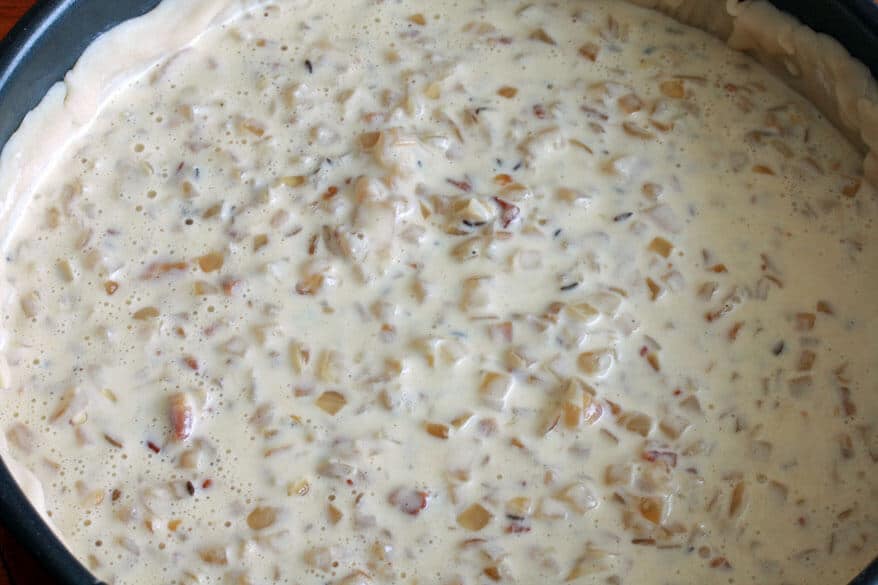
Bake in the oven preheated to 400 degrees F for 55-60 minutes or until the top is light brown and the center of the pie feels fairly firm to the touch.
Let cool for at least 20 minutes before serving. Can be eaten lukewarm or cold.

Enjoy!

For more traditional German recipes be sure to try our:
- German Apple Cake (Apfelkuchen)
- Potato Pancakes (Kartoffelpuffer)
- Sauerbraten
- Rouladen
- Schnitzel
- Bratwurst
- Maultaschen
- Currywurst
- German Bread (Vollkornbrot)
- Spaetzle
- Stollen
- German Potato Dumplings
- Bread Dumplings
Save This Recipe

Zwiebelkuchen (German Onion Pie)
Ingredients
- For the Yeast Dough Crust:
- 2 cups all-purpose flour
- 1 teaspoon salt
- 3 tablespoons butter , at room temperature and cut into small cubes
- 2/3 cup lukewarm milk
- 1 1/4 teaspoons active dry yeast (or instant yeast and add directly to flour, no need to dissolve first)
- 1 teaspoon sugar
- OR Pie Crust , half the recipe (you can use pie crust instead of the the yeast crust)
- For the filling:
- 2 tablespoons butter
- 2 ¼ lbs yellow onions ,finely diced
- 5 slices thick cut bacon ,finely diced
- 1 ½ cups full fat sour cream
- 4 large eggs ,or 3 extra large
- 2 tablespoons all-purpose flour
- 2 teaspoons salt
- 1 teaspoon caraway seeds
- Freshly ground black pepper
Instructions
- To make the crust: Dissolve the yeast and sugar in the warm milk and let stand for 5 minutes. Place the flour and salt in stand mixer and make a well in the center. Add the butter and pour the milk mixture over. Using a dough hook, knead the dough on the “bread” setting for about 6 minutes. Add more milk or flour as needed. Form the dough into a ball, spray the same bowl with oil oil, cover loosely with plastic wrap, and let the dough rise in a warm place for about an hour or until nearly doubled in size. (I usually turn the oven on 350 degrees F for about 1 minute just until it’s a warm, turn it off, and let the dough rise in the oven).
- To make the filling: Fry up the bacon. When the bacon is done add the onions to it along with 2 tablespoons of butter. Reduce the heat and let the onions slowly caramelize to a nice golden brown, about 30-40 minutes. Remove from heat and allow the mixture to cool.
- In a bowl, combine 1 ½ cups full fat sour cream, eggs, 2 tablespoons all-purpose flour, 2 teaspoons salt, 1 teaspoon caraway seeds, and some freshly ground pepper. Add the onion/bacon mixture to it and thoroughly combine everything.
- If using pie crust, grease the springform and gently press the crust into the pan, leaving about 1/2 inch or so margin along the top. If making the dough yourself, once the yeast dough has risen, butter a 9 or 10 inch springform and spread out the yeast dough on the bottom and up the sides (leaving about ½ inch from the top). The dough will keep retracting, just work fairly quickly and then immediately pour the onion mixture into it (it will hold the dough in place), sprinkle a few caraway seeds on top, and put it in the oven.
- Place the Zwiebelkuchen on the middle shelf in the oven preheated to 400 degrees F and bake for 55-60 minutes, until the top is light brown and the center of the pie feels fairly firm to the touch. Let cool for at least 20 minutes before serving. Can be eaten lukewarm or cold.
Nutrition



















Be still my heart, I think I’ve finally found a German recipe I could fall in love with. This sounds divine. I’ve dabbled with some German recipes in the past, but none of them have won me over…yet.
What???! :) Okay, Amy, if you haven’t fallen in love with any other German recipes yet you’ve been looking in the wrong places! :) Take a look at my German section by location on my recipes dropdown menu – pick any one of those and I’m pretty confident you’ll become a German food convert yet! ;)
For instance, flammkuchen…omg it’s amazing. All of the variations are amazing actually.
This looks delicious! My parents are both American but they used to live in Germany for a few years back in the early seventies (before they had kids, so I never lived there) – I’ll have to ask them if they remember eating this.
It’s one of my personal favorites, Julie. Every Autumn you can find Zwiebelkuchen in every bakery and at many roadside stalls you can find Neuer Wein and Federwasser (grape wine or freshly squeezed grape juice from the Autumn harvests) which are traditionally served with with the Zwiebelkuchen. It’s a delicious tradition!
Thank you for this mouth-watering recipe. Your photos are terrific. I will be making this very soon. Question regarding the dough: Although you specify common all-purpose flour, would you recommend using higher gluten bread flour if available? I ask for two reasons. One, I usually see yeast in many bread recipes. Two, I have a five-pound bag of bread flour in need of use! But I ultimately do not want to compromise your recipe.
Thanks so much, Rob, I really appreciate that! While you wouldn’t want to substitute bread flour for all-purpose flour to make cakes, cookies, muffins, etc, you probably could get away with it for this crust. Bread flour has a much higher protein content and so it’s just a lot harder, chewier. Since there will be a moist filling in it I think it will probably be okay for this purpose. Really the star of the show here is the filling more than anything. You can honestly even use a store-bought pie crust and you’ll love this Zwiebelkuchen just the same. Whatever you decide on, let us know how it goes!
Thanks Kimberly. Zwiebelkuchen wie zuhause :-) ( Gechingen/Calw, Baden Wuerttemberg)
Hallo, Hans! Genau, etwas ich geniessen kann wenn ich Heimweh habe (ständig). Liebe Grüsse an Gechingen!
Hi, made this and all went well, I found the filling very salty, and I only used 1 teaspoon. Is this a mistake. Should it be 1/2 tsp
Hi Beth, thanks for the feedback. No, it’s 2 teaspoons and that’s a pretty standard amount for Zwiebelkuchen. That said, salt tolerance varies greatly from person to person and as with any recipe, I recommend that if someone tends to be a little more salt sensitive to start with less. I personally don’t like overly salty foods and I’m not generally one to add salt at the table, but I don’t find this Zwiebelkuchen too salty for my taste. Again, purely personal preference though.
Made the Zwiebelkuchen again for New Years Eve, only this time I bought some finished Pizza dough and it was a total hit. Took a bit of work however to get a thin enough crust
Fantastic, so glad to hear it was a hit, Christa!
Hi did you put 2 teaspoons of salt to your filling? Thanks
Hi Kimberly: Apparently my earlier answer to your above reply did not take. So here I go again. The dough worked out after a fashion. Since it probably was thicker than what your recipe recommends, I probably should have baked the whole thing a little longer or maybe even prebaked the dough. The line between dough and filling was a bit obscured, possibly some liquid from the filling seeped into it while baking. However, the filling did not stick to the sides of the springform. The next day we warmed up some slices in the toaster oven, and the bottom crisped up nicely. The whole thing was by no means a loss,
Thanks for the feedback, Christa. Yes, yeast dough can be a little tricky to work with. When I have some more time I may go back and take some step-by-step pictures of the dough-making process. In any case, I’m glad it turned out and that you enjoyed it! Zwiebelkuchen is one of my favorite German dishes.
As anticipated, I had problems with the dough. In fact, I tossed the first batch, sent hubby to the store for new yeast, and started all over again with no better results. However, I do admit I have never been great working with yeast. I used the second batch anyway and added the filling on top. It turned out just absolutely delicious and I am a convert. My American husband, having had Zwiebelkuchen during prior visits to Germany, thought it was the best ever, especially after reheating and crisping individual slices in the toaster oven. But I am still puzzled regarding the dough especially since I will have to make it again.
Hi Christa, I am so happy you both enjoyed it and appreciate the feedback! Okay, let’s troubleshoot the dough: So the second time you said the dough turned out the same but that you went ahead and used it and the Zwiebelkuchen turned out great. So did the dough work out after all? Did it bake properly with the filling in it?